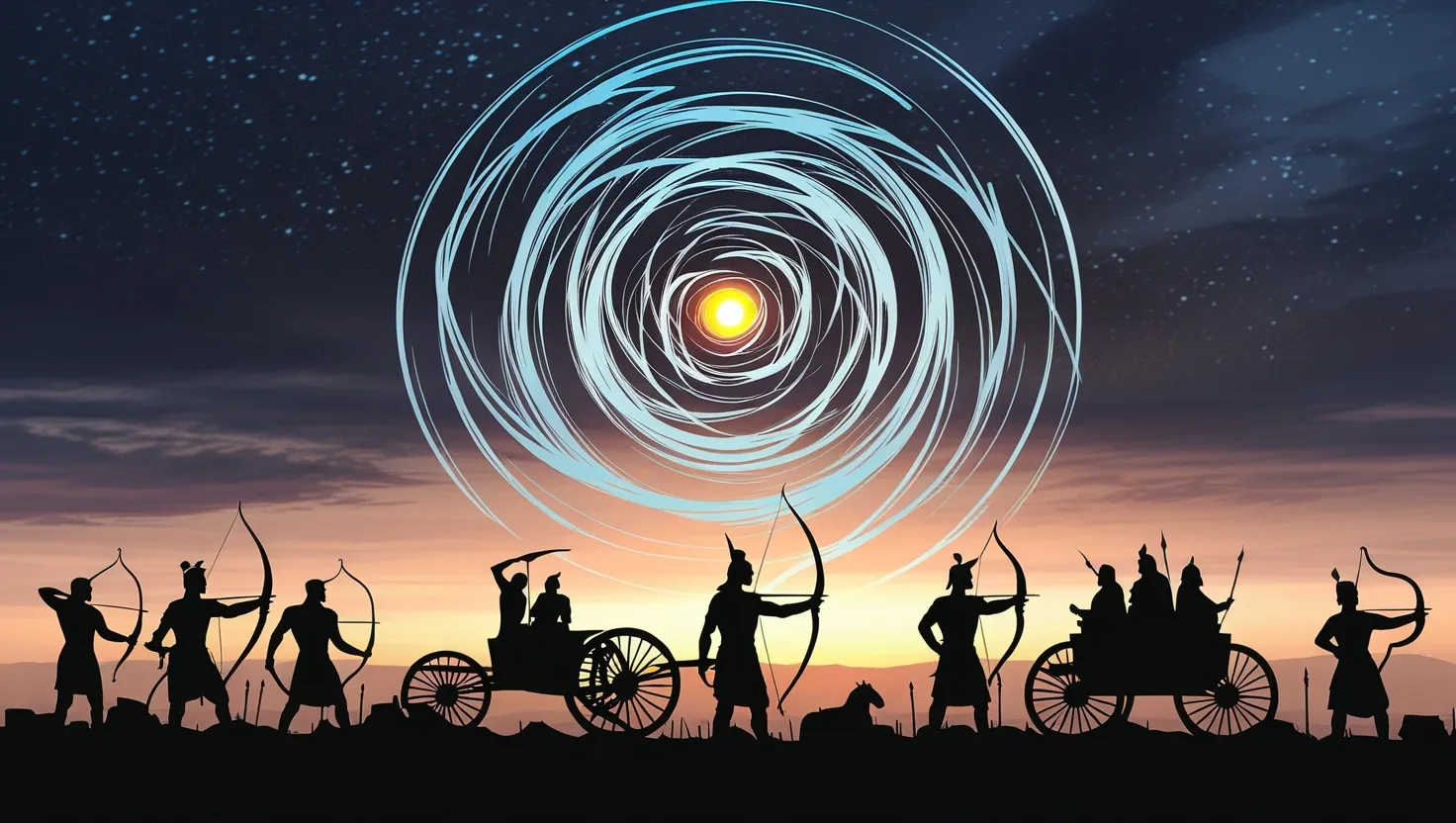The dense canopy of trees looms overhead as we step into the sacred forests of the Mahabharata. These verdant realms are far more than mere backdrops - they are living, breathing characters that shape the epic’s spiritual journey. As we wander deeper, the modern world fades away and we find ourselves immersed in spaces of profound transformation.
The Pandavas’ exile takes on new meaning when we view it through the lens of the forest. What initially seems a harsh punishment becomes a crucible for growth. Stripped of their royal trappings, the brothers are forced to confront their true selves. The forest doesn’t coddle them - it challenges them at every turn. Yet in facing those trials, they discover inner reserves of strength and wisdom.
Can you recall a time when stepping away from your comfort zone led to unexpected insights?
In the Kamyaka Forest, we witness the Pandavas’ education unfold in ways that no palace could provide. Here, they learn the art of warfare not from courtly tutors, but from celestial beings. Divine weapons are bestowed upon them, their power amplified by the primal energy of the wilderness. Even lessons in statecraft take on new dimensions when taught amid nature’s complex ecosystems.
The forest strips away pretense, leaving only the essence. For Nala and Damayanti, royal lovers separated by fate, the wilderness becomes a forge for their characters. As they struggle to survive, shorn of wealth and status, they rediscover not only each other but their own hidden depths. The forest doesn’t care about titles or lineage - it demands authenticity.
“In the forest, I entered into my own self and saw with clarity.” - Bhishma
This sentiment echoes throughout the epic. Time and again, characters retreat to the forest to gain perspective and reconnect with their spiritual core. Even Krishna, the divine incarnate, frequently seeks the solace of the woods. What is it about these spaces that fosters such profound introspection?
Perhaps it’s the way the forest mirrors our inner landscape. Its tangled paths reflect the winding journey of self-discovery. Its cycles of growth, decay, and rebirth echo the eternal dance of the soul. In the forest, we’re confronted with both the fragility of life and its tenacious will to thrive.
The story of Savitri’s encounter with Yama in the forest takes on added resonance when we consider the setting. As she debates the lord of death for her husband’s soul, the trees stand as silent witnesses. Their ancient roots reach deep into the underworld, while their branches stretch towards the heavens - a perfect backdrop for this liminal moment between life and death.
How might your own spiritual practice be enriched by spending time in nature?
The Mahabharata doesn’t shy away from the forest’s dangers. Tigers prowl, demons lurk, and harsh elements test the body’s limits. Yet it’s precisely these challenges that forge heroic spirits. The Pandavas emerge from their forest sojourn not weakened, but tempered like fine steel.
We see this reflected in the arc of Arjuna’s character. His time spent in the forest honing his skills transforms him from a talented prince into a warrior of unparalleled prowess. But more than that, it deepens his spiritual understanding. When Krishna delivers the Bhagavad Gita on the battlefield, Arjuna is ready to receive its wisdom precisely because of his forest-forged insight.
The epic also highlights the forest as a realm of magical encounters. Supernatural beings - whether benevolent or malevolent - seem to find it easier to manifest in these liminal spaces. Perhaps there’s a lesson here about how nature can thin the veil between worlds, allowing us to perceive realities beyond the mundane.
“The forest knows secrets I have yet to learn.” - Yudhishthira
This humble acknowledgment from the eldest Pandava speaks volumes. Even for one renowned for his wisdom, the forest remains a source of endless teachings. It’s a reminder that no matter how much we think we know, nature always has more to reveal.
The Mahabharata’s treatment of sacred forests offers a powerful counterpoint to modern attitudes towards nature. Instead of seeing wilderness as something to be conquered or exploited, the epic presents it as a realm of profound spiritual significance. It’s a perspective sorely needed in our era of environmental crisis.
Consider how the forest dwellers in the epic - the sages, ascetics, and mystics - live in harmony with their surroundings. They take only what they need and offer reverence in return. This isn’t depicted as deprivation, but as a path to enlightenment. What might our world look like if we adopted a similar ethos?
The forest’s role in the Mahabharata extends beyond individual growth - it’s also crucial to the larger cosmic drama. Many pivotal moments unfold beneath its leafy canopy. Promises are made, alliances forged, and destinies set in motion. The forest becomes a stage where the play of karma and dharma unfolds.
One of the most poignant examples is the fire that consumes the Khandava Forest. While on the surface it’s a display of divine power, it also serves as a metaphor for the cleansing destruction that sometimes precedes renewal. The forest’s burning foreshadows the great war to come, with all its terrible losses and ultimate restoration of dharma.
How do you reconcile the forest’s nurturing aspects with its potential for destruction? What lessons might this duality hold?
As we delve deeper into the Mahabharata’s sacred forests, we begin to see them not just as physical locations, but as states of being. To enter the forest is to step into a liminal space where transformation becomes possible. It’s a realm where the lines between the mundane and the divine blur, where everyday concerns fall away and deeper truths emerge.
This is beautifully illustrated in the story of Nachiketa, who enters the forest to seek wisdom from Yama. The forest becomes a threshold between life and death, a place where the young seeker can confront the ultimate mysteries. It’s telling that this profound spiritual instruction doesn’t happen in a temple or palace, but in the wild.
The epic’s emphasis on forest retreats also speaks to the value of periodic withdrawal from society. By stepping away from the noise and obligations of everyday life, characters gain the space to reflect, grow, and realign with their higher purpose. In our hyper-connected modern world, perhaps we could all benefit from such forest interludes.
“In the silence of the forest, the self speaks loudest.” - Vidura
This insight from the wise Vidura encapsulates a core teaching of the Mahabharata. The forest’s quiet isn’t empty - it’s pregnant with potential. When we silence the external chatter, we create space for inner wisdom to emerge.
The Mahabharata’s sacred forests also serve as repositories of ancient knowledge. Sages pass down oral traditions, hidden texts are discovered, and long-forgotten skills are revived. The forest becomes a living library, preserving wisdom that might otherwise be lost to time.
This aspect of the forest takes on added significance when we consider the environmental challenges we face today. How much knowledge - medicinal, ecological, spiritual - might be lost as forests around the world disappear? The epic’s reverence for forest wisdom feels particularly poignant in this light.
As our journey through the Mahabharata’s sacred forests draws to a close, we’re left with a profound appreciation for nature’s role in spiritual growth. These wild spaces are not obstacles to be overcome, but teachers to be heeded. They offer challenges that forge strength, beauty that inspires wisdom, and silence that nurtures self-knowledge.
The epic reminds us that sometimes, to move forward on our spiritual path, we need to step off the beaten track. By immersing ourselves in nature, we open ourselves to transformative experiences. We remember our place in the great web of life and reconnect with the divine that pulses through all creation.
What forests - literal or metaphorical - might be calling you to enter? What wisdom might be waiting for you there, if only you have the courage to step in?
As we emerge from our exploration of the Mahabharata’s sacred forests, we carry with us a renewed sense of nature’s spiritual power. Perhaps we’ll look at the world around us with fresh eyes, seeing potential for growth and enlightenment in every leaf and stone. For in the end, the epic teaches us that the sacred forest isn’t just a place in an ancient story - it’s a state of mind we can cultivate wherever we are.






